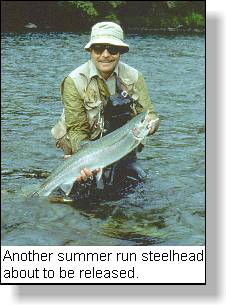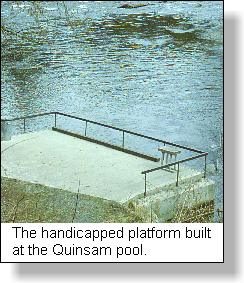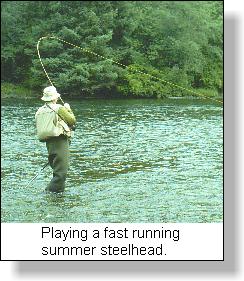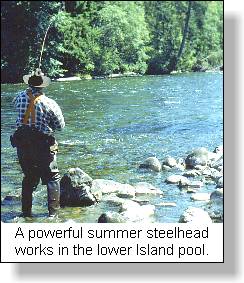
Experiencing BC Rivers Series
STEELHEADING
on the
CAMPBELL RIVER
with Barry M. Thornton
 The "Poor Man's Dean"; the "River of No Return";
these are but a few of the affectionate phrases used by steelheaders to
describe the Campbell River. My first experiences with the Campbell River
were fraught with intimidation. It is too large, I kept telling myself.
What if I hook a big fish, how will I ever land it in those frothing white
waters? I had learned my steelheading on the smaller Vancouver Island streams like the Qualicums, the Oyster
and the Quinsam, where it was natural to wade across the river and play
powerful fighting fish in pools that contain the aggression. I was convinced
that this would not be so on the Campbell River!
It took me many years to overcome this feeling for one of Vancouver Island's
largest rivers. But, when I lost my unfamiliarity with water flows, pools
and large powerful steelhead, I was astounded at how successful anglers
can be on this exciting river.
The Campbell River was made famous in the writing of Canada's most thoughtful
and prolific fishing writer, Roderick Haig-Brown. He spoke of this river,
his home water, in glowing terms with a rare understanding of the habits
and environmental needs of fish, long before salmonids became popular. I
was fortunate to work closely with Rod on a number of provincial steelhead
concerns and still recall my visits with him in his library on the banks
of the Campbell River.
Steelhead in the Campbell River are of both the summer and the winter
races. The winter steelhead begin entering the river late in November and
continue through to mid April. Summer steelhead begin their entry in June,
with major runs occurring in late summer and early fall.
 The winter steelheader has
the opportunity to catch both Campbell winter steelhead and Quinsam River
winter steelhead in those pools below the confluence of the Quinsam with
the Campbell. Without question the most popular fishing water lies immediately
below where the Quinsam enters the Campbell. However, in recent years a
major Quinsam/Campbell steelhead pool has formed on the Quinsam just prior
to its entry with the Campbell. This pool is so productive that a special
handicapped fishing platform has been constructed on the upper side of the
river. Downstream, the equally popular 'Sandy Pool' immediately below the
logging bridge always seems to host a number of anglers during the winter
season. Those who are most successful are tide watchers, and are ready and
waiting for fresh fish which enter the Campbell to arrive at the 'Sandy
Pool' between two and four hours after every high tide. The winter steelheader has
the opportunity to catch both Campbell winter steelhead and Quinsam River
winter steelhead in those pools below the confluence of the Quinsam with
the Campbell. Without question the most popular fishing water lies immediately
below where the Quinsam enters the Campbell. However, in recent years a
major Quinsam/Campbell steelhead pool has formed on the Quinsam just prior
to its entry with the Campbell. This pool is so productive that a special
handicapped fishing platform has been constructed on the upper side of the
river. Downstream, the equally popular 'Sandy Pool' immediately below the
logging bridge always seems to host a number of anglers during the winter
season. Those who are most successful are tide watchers, and are ready and
waiting for fresh fish which enter the Campbell to arrive at the 'Sandy
Pool' between two and four hours after every high tide.
Immediately upstream above the confluence of the two rivers, is the 'Quinsam
Pool.' This is classic steelhead holding water, and is easily accessible
and fished from the highway side.
Looking upstream from the Quinsam Pool, the river takes a crescent bend
and shelves at the "Pump House Pool'. On the south side it is shallow
(slippery) and 'anywhere' steelhead holding water. Depending on water levels
fish will most commonly be found in the tailout shallows or along the edge
of the shelf leading into the main current. Deep holding water on the north
side also holds many fish particularly at the head and tailout sections.
Fly Fishing only water occurs above the 'Pump House Pool' and this is
supported strongly by most steelheaders. It is in this water, about a mile
and a half to the John Hart Power Station, that summer steelhead are sought
by anglers around the world. I can remember 'picket line' fly fishing one
pool last year with a group of Germans on my left and a group of Japanese
on my right. Communication was no barrier in our numerous contacts during
the day for the language of fly fishing is universal!
 The fly fishing only section
of the river, that special upper water, contains a number of classic summer
fly fishing waters. However, none is as productive or as fishy as the run
between the upper and lower islands. This, the Mid-Island Pool, is a lengthy
300 yard run of water flowing from riffles into a deep fast flowing trough.
It can best be visualized as a gigantic 300 yard airplane wing with the
water flowing from the thin back, the riffle, over the deeper front, the
pool or run. As water levels increase or decrease the fish move back and
forth from riffle to pool. It is fishable along it's full length and can
take a fly fisher a full day to cover all productive holding water. In this
one stretch of popular water it is not uncommon to find 6 or more anglers
fly fishing at any time. It is interesting that never have I not been unable
to fish this stretch because of angler numbers. Island steelheaders and
visitors do follow fly fishing ethics and move downstream after a few casts
with the bottom angler in the row moving to the top of the run to work down
once again. The fly fishing only section
of the river, that special upper water, contains a number of classic summer
fly fishing waters. However, none is as productive or as fishy as the run
between the upper and lower islands. This, the Mid-Island Pool, is a lengthy
300 yard run of water flowing from riffles into a deep fast flowing trough.
It can best be visualized as a gigantic 300 yard airplane wing with the
water flowing from the thin back, the riffle, over the deeper front, the
pool or run. As water levels increase or decrease the fish move back and
forth from riffle to pool. It is fishable along it's full length and can
take a fly fisher a full day to cover all productive holding water. In this
one stretch of popular water it is not uncommon to find 6 or more anglers
fly fishing at any time. It is interesting that never have I not been unable
to fish this stretch because of angler numbers. Island steelheaders and
visitors do follow fly fishing ethics and move downstream after a few casts
with the bottom angler in the row moving to the top of the run to work down
once again.
Two other stretches of fly fishing water are also notable. The first
is the deeper run immediately below the John Hart Hydro outflow. This is
fast water but one of the areas where steelhead stockpile as they cannot
travel upstream much farther. This is rippling dancing surface water that
is ideal for skating dry flies like the Western Bee perfected by Roderick
Haig-Brown for this river and the much smaller Heber River on the west coast
of Vancouver Island. Bomber and high riding white rubber-leg patterns also
entice striking steelhead to rise from June through October.
The second notable water is the Lower Island Pool. This is the water
which is the closest to an actual pool. Here the river pours over a series
of rocks then slows as it levels just above the lower island. Steelhead
tend to hold in the faster tailout of this pool but, depending upon water
flows, can be found anywhere in this fishy stretch including the fast whitewater
prior to the pool. This stretch of water, like the Mid Island Pool is streamer
water. Be prepared for these lunker steelhead like to capture the fast flow
of the current when they are hooked and, they have a habit of running downstream.
A good length of backing is a must for these large rainbow-hued trophies.
 Access to the short Campbell
River is primarily on the south side from the Island Highway which borders
the fishing portion of the river. Regulations state that all steelhead must
be released above the Comox logging road bridge and fly fishing only is
permitted from the John Hart Power station downstream to the powerline crossing
at the 'Pump House' pool. Access to the short Campbell
River is primarily on the south side from the Island Highway which borders
the fishing portion of the river. Regulations state that all steelhead must
be released above the Comox logging road bridge and fly fishing only is
permitted from the John Hart Power station downstream to the powerline crossing
at the 'Pump House' pool.
Concern is often expressed about writers providing detail on specific
rivers or lakes - the giving away of 'secret' fishing holes. I do not fear
for steelhead rivers if there is an article published about them. Rather,
I feel that steelheaders are natural river guardians and, with publicity
comes angling numbers who will ensure protection for our streams. Steelheading
is site and time specific, even telling the exact 'where' is no guarantee
that steelhead will be there when you arrive. Steelhead are migrating fish
whose habits are dictated by season, tide and water flow. Sharing knowledge
of these rivers is the greatest guarantee we have that the resource and
the river will be a gift we pass on to the next generation.
Remember, an unknown river has no friends - no champions!
© Copyright Barry M. Thornton
Barry M. Thornton
| 




 The winter steelheader has
the opportunity to catch both Campbell winter steelhead and Quinsam River
winter steelhead in those pools below the confluence of the Quinsam with
the Campbell. Without question the most popular fishing water lies immediately
below where the Quinsam enters the Campbell. However, in recent years a
major Quinsam/Campbell steelhead pool has formed on the Quinsam just prior
to its entry with the Campbell. This pool is so productive that a special
handicapped fishing platform has been constructed on the upper side of the
river. Downstream, the equally popular 'Sandy Pool' immediately below the
logging bridge always seems to host a number of anglers during the winter
season. Those who are most successful are tide watchers, and are ready and
waiting for fresh fish which enter the Campbell to arrive at the 'Sandy
Pool' between two and four hours after every high tide.
The winter steelheader has
the opportunity to catch both Campbell winter steelhead and Quinsam River
winter steelhead in those pools below the confluence of the Quinsam with
the Campbell. Without question the most popular fishing water lies immediately
below where the Quinsam enters the Campbell. However, in recent years a
major Quinsam/Campbell steelhead pool has formed on the Quinsam just prior
to its entry with the Campbell. This pool is so productive that a special
handicapped fishing platform has been constructed on the upper side of the
river. Downstream, the equally popular 'Sandy Pool' immediately below the
logging bridge always seems to host a number of anglers during the winter
season. Those who are most successful are tide watchers, and are ready and
waiting for fresh fish which enter the Campbell to arrive at the 'Sandy
Pool' between two and four hours after every high tide. The fly fishing only section
of the river, that special upper water, contains a number of classic summer
fly fishing waters. However, none is as productive or as fishy as the run
between the upper and lower islands. This, the Mid-Island Pool, is a lengthy
300 yard run of water flowing from riffles into a deep fast flowing trough.
It can best be visualized as a gigantic 300 yard airplane wing with the
water flowing from the thin back, the riffle, over the deeper front, the
pool or run. As water levels increase or decrease the fish move back and
forth from riffle to pool. It is fishable along it's full length and can
take a fly fisher a full day to cover all productive holding water. In this
one stretch of popular water it is not uncommon to find 6 or more anglers
fly fishing at any time. It is interesting that never have I not been unable
to fish this stretch because of angler numbers. Island steelheaders and
visitors do follow fly fishing ethics and move downstream after a few casts
with the bottom angler in the row moving to the top of the run to work down
once again.
The fly fishing only section
of the river, that special upper water, contains a number of classic summer
fly fishing waters. However, none is as productive or as fishy as the run
between the upper and lower islands. This, the Mid-Island Pool, is a lengthy
300 yard run of water flowing from riffles into a deep fast flowing trough.
It can best be visualized as a gigantic 300 yard airplane wing with the
water flowing from the thin back, the riffle, over the deeper front, the
pool or run. As water levels increase or decrease the fish move back and
forth from riffle to pool. It is fishable along it's full length and can
take a fly fisher a full day to cover all productive holding water. In this
one stretch of popular water it is not uncommon to find 6 or more anglers
fly fishing at any time. It is interesting that never have I not been unable
to fish this stretch because of angler numbers. Island steelheaders and
visitors do follow fly fishing ethics and move downstream after a few casts
with the bottom angler in the row moving to the top of the run to work down
once again. Access to the short Campbell
River is primarily on the south side from the Island Highway which borders
the fishing portion of the river. Regulations state that all steelhead must
be released above the Comox logging road bridge and fly fishing only is
permitted from the John Hart Power station downstream to the powerline crossing
at the 'Pump House' pool.
Access to the short Campbell
River is primarily on the south side from the Island Highway which borders
the fishing portion of the river. Regulations state that all steelhead must
be released above the Comox logging road bridge and fly fishing only is
permitted from the John Hart Power station downstream to the powerline crossing
at the 'Pump House' pool.